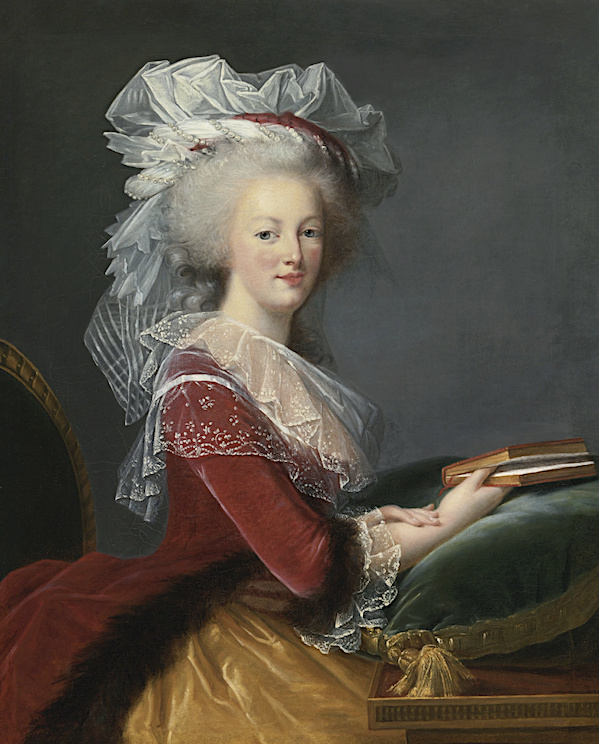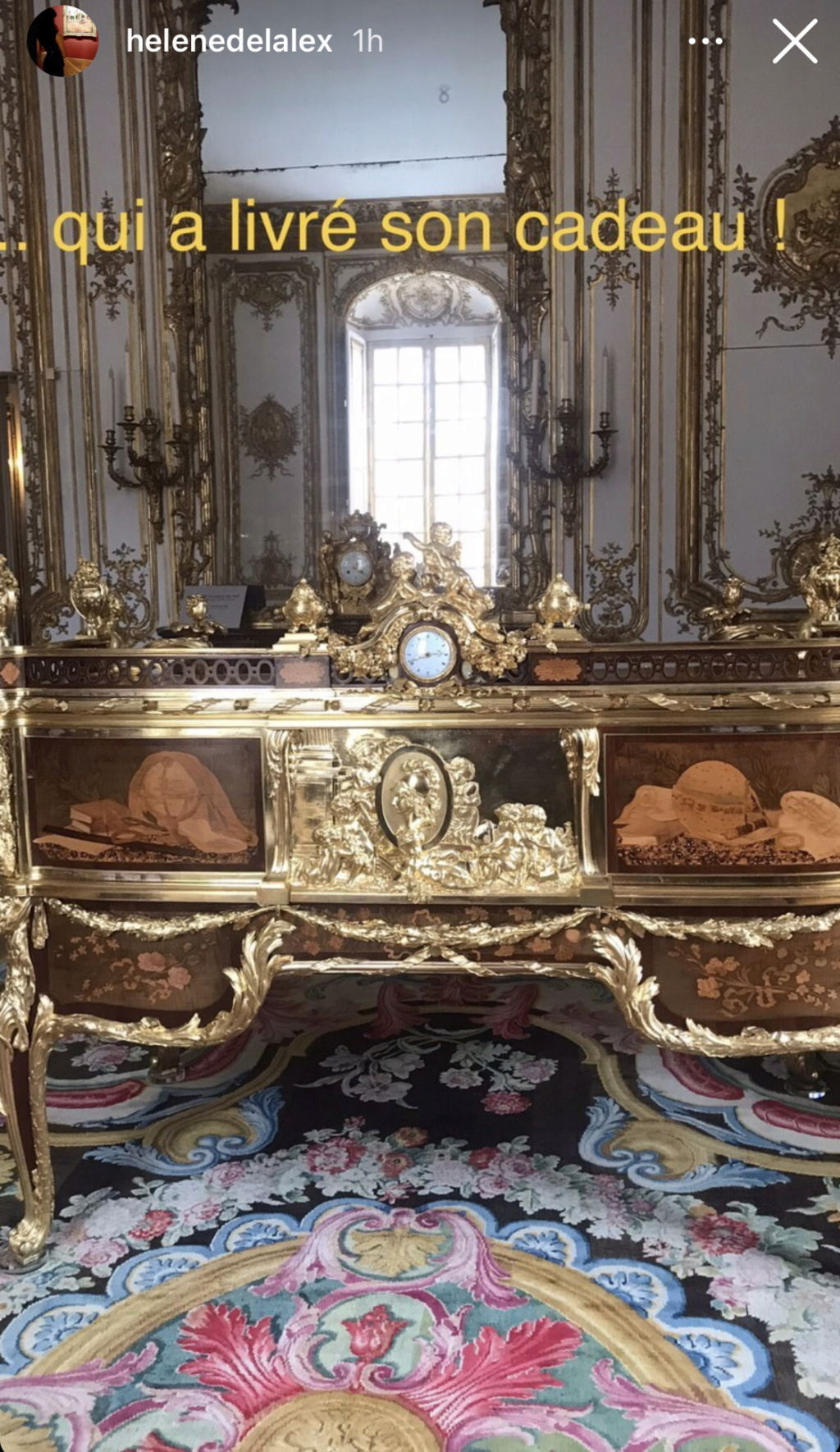Jean-Henri Riesener, ébéniste du XVIIIe siècle
+5
Teresa-Cabarrus
Duc d'Ostrogothie
Gouverneur Morris
La nuit, la neige
Mme de Sabran
9 participants
LE FORUM DE MARIE-ANTOINETTE :: La France et le Monde au XVIIIe siècle :: Les Arts et l'artisanat au XVIIIe siècle :: Le mobilier du XVIIIe siècle
Page 2 sur 2
Page 2 sur 2 •  1, 2
1, 2

Gouverneur Morris- Messages : 11352
Date d'inscription : 21/12/2013
 Re: Jean-Henri Riesener, ébéniste du XVIIIe siècle
Re: Jean-Henri Riesener, ébéniste du XVIIIe siècle
Que c'est beau ces meubles haut de game

Mr ventier- Messages : 1088
Date d'inscription : 18/11/2020
Age : 58
Localisation : Rouen normandie
 Re: Jean-Henri Riesener, ébéniste du XVIIIe siècle
Re: Jean-Henri Riesener, ébéniste du XVIIIe siècle
Dans le cadre de la " saison Riesener ", organisée par la Wallace Collection et présentée dans nos messages précédents, et conjointement à la publication du livre de référence que nous présentons : ICI
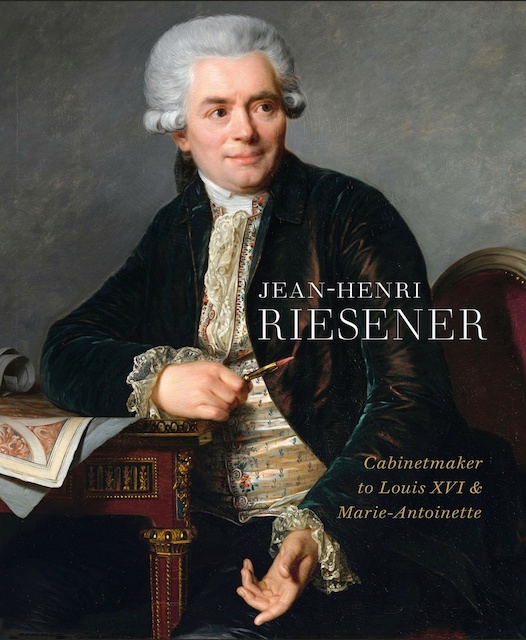
Je vous propose de découvrir trois longues vidéos, mises en lignes par la Wallace Collection, durant lesquelles experts et conservateurs (dont les auteurs du livre ci-dessus) nous présentent...
1) MEMOIRES OT THE GARDE-MEUBLES : RIESENER'S PERSPECTIVES ON ROYAL FURNITURE
Riesener was court cabinetmaker for over ten years, supplying over 700 pieces to the French royal household. The details of these commissions were recorded in the Journal of the Garde-Meuble (the department of the royal household responsible for ordering and managing furnishings), as well as Riesener’s mémoires. These were invoices which contained detailed descriptions of the furniture, as well as the materials and techniques used to make them.
Many of Riesener’s invoices survive and can be found in the collections of the Archives nationales and Bibliothèque nationale de France.
Our final talk in the series will explore a selection of invoices for pieces of royal furniture at Waddesdon Manor and the Royal Collection. They will tell us more about Riesener’s design and workshop processes, as well as the challenges he encountered during exceptionally ambitious projects.
The Wallace Collection is delighted to present this talk as part of a series of three talks on Riesener, in collaboration with the Furniture History Society.
2) RIESENER MASTERPIECES : ROYAL FURNITURE IN BRITAN
In the second talk in our series, speakers from the Wallace Collection, Royal Collection and Waddesdon Manor will discuss some of the 30 pieces in their care. These include celebrated works made for Marie-Antoinette, Louis XVI and the French royal family that demonstrate the extraordinary levels of skilled craftsmanship achieved in the Riesener workshop and the design sophistication of which Riesener was capable.
Our speakers will consider the popularity of French royal furniture in Britain in the 19th century and will illustrate the talk with stunning new photography from all three collections, revealing findings from the collaborative Riesener Project and shedding new light on both Riesener's techniques and the provenance of some of the furniture.
3) CREATING A MARKET : DEALERS, AUCTIONEERS AND THE PASSION FOR RIESENER FURNITURE, 1880 - 1882
Jean-Henri Riesener (1734-1806), cabinetmaker to Louis XVI, was one of the most celebrated cabinetmakers of the French eighteenth century. He was also a phenomenon in the history of British art collecting, becoming a byword in the nineteenth century for all that was admired in French furniture.
Before the French Revolution we have no evidence of a British patron, yet just fifty years later collectors like William Beckford, George IV and the 4th Marquess of Hertford had contributed to both his celebrity and the prices his furniture achieved.
The nineteenth-century popularity of Riesener furniture was more than just an appreciation of the cabinetmaker’s designs and the quality of their execution; it was driven by a fascination for the ancien régime and romanticized views of the doomed Bourbon Court. It was also an indication of the resourcefulness of the innovative entrepreneurs and dealers in France and England who helped establish Riesener’s reputation in the decades following the Revolution.
Through clever marketing techniques and a certain amount of ‘enhancement’, they educated a new generation of buyers and established Riesener’s name alongside that of André-Charles Boulle as being worthy of connoisseurs.
This paper will analyze the rise of Riesener’s celebrity and the dealers who made it happen. It will discuss the sales techniques of the early nineteenth-century auctioneers, the role played by connoisseurs such as Lord Hertford, and the democratization of Riesener furniture through the market for copies and reproductions. It will end with the Hamilton Palace sale of 1882, which opened up yet another new market for Riesener: the Americans.

Je vous propose de découvrir trois longues vidéos, mises en lignes par la Wallace Collection, durant lesquelles experts et conservateurs (dont les auteurs du livre ci-dessus) nous présentent...
1) MEMOIRES OT THE GARDE-MEUBLES : RIESENER'S PERSPECTIVES ON ROYAL FURNITURE
Riesener was court cabinetmaker for over ten years, supplying over 700 pieces to the French royal household. The details of these commissions were recorded in the Journal of the Garde-Meuble (the department of the royal household responsible for ordering and managing furnishings), as well as Riesener’s mémoires. These were invoices which contained detailed descriptions of the furniture, as well as the materials and techniques used to make them.
Many of Riesener’s invoices survive and can be found in the collections of the Archives nationales and Bibliothèque nationale de France.
Our final talk in the series will explore a selection of invoices for pieces of royal furniture at Waddesdon Manor and the Royal Collection. They will tell us more about Riesener’s design and workshop processes, as well as the challenges he encountered during exceptionally ambitious projects.
The Wallace Collection is delighted to present this talk as part of a series of three talks on Riesener, in collaboration with the Furniture History Society.
2) RIESENER MASTERPIECES : ROYAL FURNITURE IN BRITAN
In the second talk in our series, speakers from the Wallace Collection, Royal Collection and Waddesdon Manor will discuss some of the 30 pieces in their care. These include celebrated works made for Marie-Antoinette, Louis XVI and the French royal family that demonstrate the extraordinary levels of skilled craftsmanship achieved in the Riesener workshop and the design sophistication of which Riesener was capable.
Our speakers will consider the popularity of French royal furniture in Britain in the 19th century and will illustrate the talk with stunning new photography from all three collections, revealing findings from the collaborative Riesener Project and shedding new light on both Riesener's techniques and the provenance of some of the furniture.
3) CREATING A MARKET : DEALERS, AUCTIONEERS AND THE PASSION FOR RIESENER FURNITURE, 1880 - 1882
Jean-Henri Riesener (1734-1806), cabinetmaker to Louis XVI, was one of the most celebrated cabinetmakers of the French eighteenth century. He was also a phenomenon in the history of British art collecting, becoming a byword in the nineteenth century for all that was admired in French furniture.
Before the French Revolution we have no evidence of a British patron, yet just fifty years later collectors like William Beckford, George IV and the 4th Marquess of Hertford had contributed to both his celebrity and the prices his furniture achieved.
The nineteenth-century popularity of Riesener furniture was more than just an appreciation of the cabinetmaker’s designs and the quality of their execution; it was driven by a fascination for the ancien régime and romanticized views of the doomed Bourbon Court. It was also an indication of the resourcefulness of the innovative entrepreneurs and dealers in France and England who helped establish Riesener’s reputation in the decades following the Revolution.
Through clever marketing techniques and a certain amount of ‘enhancement’, they educated a new generation of buyers and established Riesener’s name alongside that of André-Charles Boulle as being worthy of connoisseurs.
This paper will analyze the rise of Riesener’s celebrity and the dealers who made it happen. It will discuss the sales techniques of the early nineteenth-century auctioneers, the role played by connoisseurs such as Lord Hertford, and the democratization of Riesener furniture through the market for copies and reproductions. It will end with the Hamilton Palace sale of 1882, which opened up yet another new market for Riesener: the Americans.

La nuit, la neige- Messages : 17787
Date d'inscription : 21/12/2013
 Re: Jean-Henri Riesener, ébéniste du XVIIIe siècle
Re: Jean-Henri Riesener, ébéniste du XVIIIe siècle
Les vidéos sont en anglais.
 Je rappelle, au cas où certains d'entre nous l'ignorent, qu'il existe une fonction traduction sur le site Youtube.
Je rappelle, au cas où certains d'entre nous l'ignorent, qu'il existe une fonction traduction sur le site Youtube.
Elle est approximative, mais bien suffisante si vous avez besoin d'une traduction.
L'anglais est la langue définie par défaut, mais il vous suffit de sélectionner le français, grâce à cet outil :
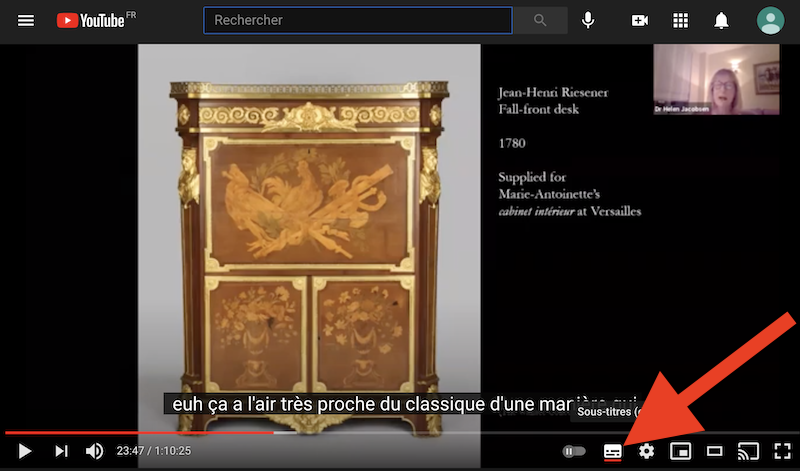
Elle est approximative, mais bien suffisante si vous avez besoin d'une traduction.
L'anglais est la langue définie par défaut, mais il vous suffit de sélectionner le français, grâce à cet outil :


La nuit, la neige- Messages : 17787
Date d'inscription : 21/12/2013
 Re: Jean-Henri Riesener, ébéniste du XVIIIe siècle
Re: Jean-Henri Riesener, ébéniste du XVIIIe siècle
Mise en ligne également par la Wallace Collection, cette courte vidéo, très bien faite, illustre la complexité de réalisation d'un secrétaire à cylindre.
Quel travail !
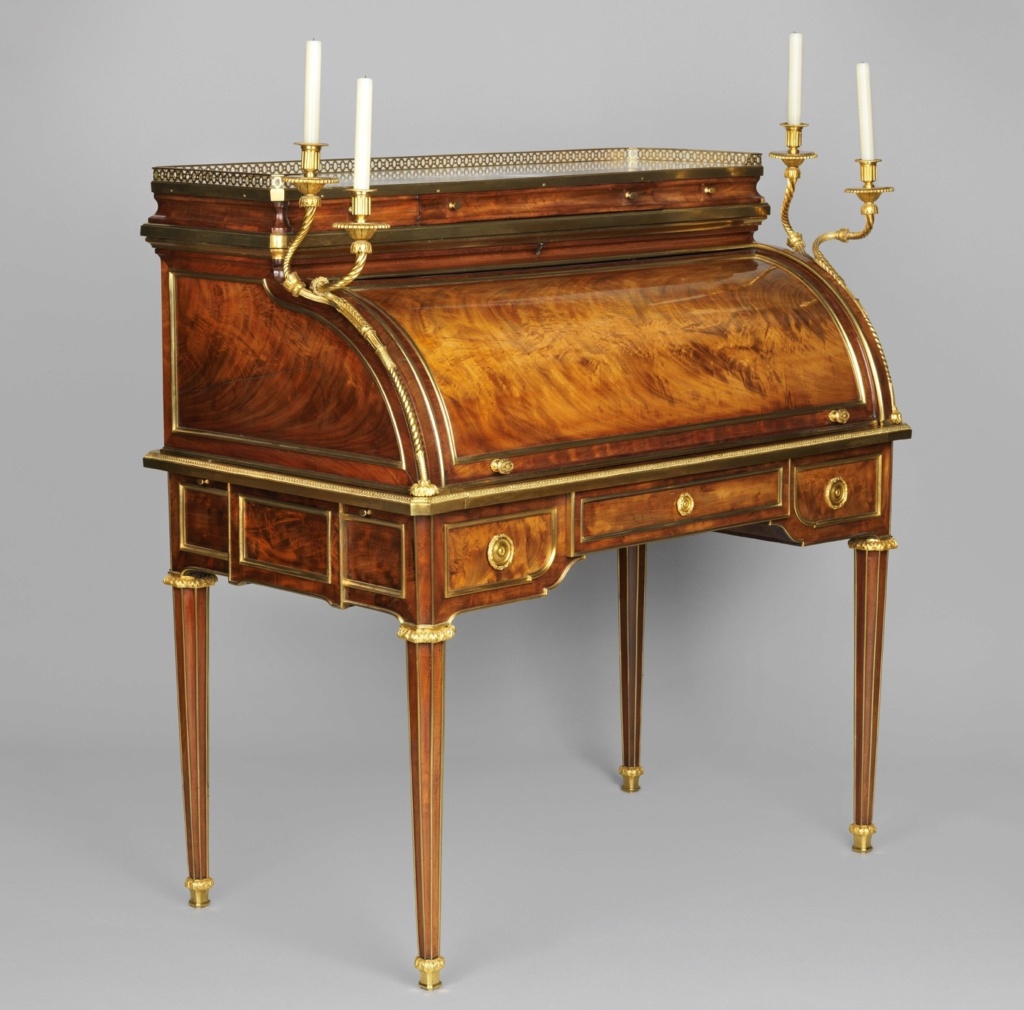
Roll-top desk
Attributed to Jean-Henri Riesener
France, c. 1785
Oak, mahogany, Carrara marble, gilt-bronze and leather
Inscription, in chalk : 'Il n'est plus là il ne / s'occupe plus de rien / J'en ai parlé / D'avance / Mon fils et moi / C'est la même chose'
Image : The Wallace Collection
Description :
Although unstamped, this desk can be securely attributed to Riesener on stylistic grounds. It is very similar to the roll-top desk he supplied for Marie-Antoinette’s private apartment at the Tuileries in December 1784, now in the Louvre, and to the cylinder desk veneered with mother-of-pearl supplied by him for Marie-Antoinette's boudoir at Fontainebleau. There are other descriptions in the royal accounts of similar desks by Riesener.
Riesener has used a carefully chosen mahogany veneer to provide the decorative effec t; now faded, its colour would have once been much richer and the ‘flame’ effect more pronounced. The candelabra on either side were to provide light for someone working at the desk.
At the top of the desk a writing-stand can be pulled out – in his bill for a roll-top desk for Thierry de Ville d’Avray, Riesener described the stand as being intended for writing when standing up.(...)
Quel travail !


Roll-top desk
Attributed to Jean-Henri Riesener
France, c. 1785
Oak, mahogany, Carrara marble, gilt-bronze and leather
Inscription, in chalk : 'Il n'est plus là il ne / s'occupe plus de rien / J'en ai parlé / D'avance / Mon fils et moi / C'est la même chose'
Image : The Wallace Collection
Description :
Although unstamped, this desk can be securely attributed to Riesener on stylistic grounds. It is very similar to the roll-top desk he supplied for Marie-Antoinette’s private apartment at the Tuileries in December 1784, now in the Louvre, and to the cylinder desk veneered with mother-of-pearl supplied by him for Marie-Antoinette's boudoir at Fontainebleau. There are other descriptions in the royal accounts of similar desks by Riesener.
Riesener has used a carefully chosen mahogany veneer to provide the decorative effec t; now faded, its colour would have once been much richer and the ‘flame’ effect more pronounced. The candelabra on either side were to provide light for someone working at the desk.
At the top of the desk a writing-stand can be pulled out – in his bill for a roll-top desk for Thierry de Ville d’Avray, Riesener described the stand as being intended for writing when standing up.(...)

La nuit, la neige- Messages : 17787
Date d'inscription : 21/12/2013
 Re: Jean-Henri Riesener, ébéniste du XVIIIe siècle
Re: Jean-Henri Riesener, ébéniste du XVIIIe siècle
Merci beaucoup LNLN 


Gouverneur Morris- Messages : 11352
Date d'inscription : 21/12/2013

Gouverneur Morris- Messages : 11352
Date d'inscription : 21/12/2013
 Re: Jean-Henri Riesener, ébéniste du XVIIIe siècle
Re: Jean-Henri Riesener, ébéniste du XVIIIe siècle
Bonne nouvelle.
_________________
Un verre d'eau pour la Reine.

Mr de Talaru- Messages : 3186
Date d'inscription : 02/01/2014
Age : 65
Localisation : près des Cordeliers...

Gouverneur Morris- Messages : 11352
Date d'inscription : 21/12/2013
 Jean-Henri Riesener et Marie-Antoinette
Jean-Henri Riesener et Marie-Antoinette
La nuit, la neige a écrit:
2) RIESENER MASTERPIECES : ROYAL FURNITURE IN BRITAN
Parmi les meubles décrits par les experts, nous retrouvons plus précisément ceux de Marie-Antoinette, et notamment...
- Curseur temps à la 23ème minute de la vidéo pour :
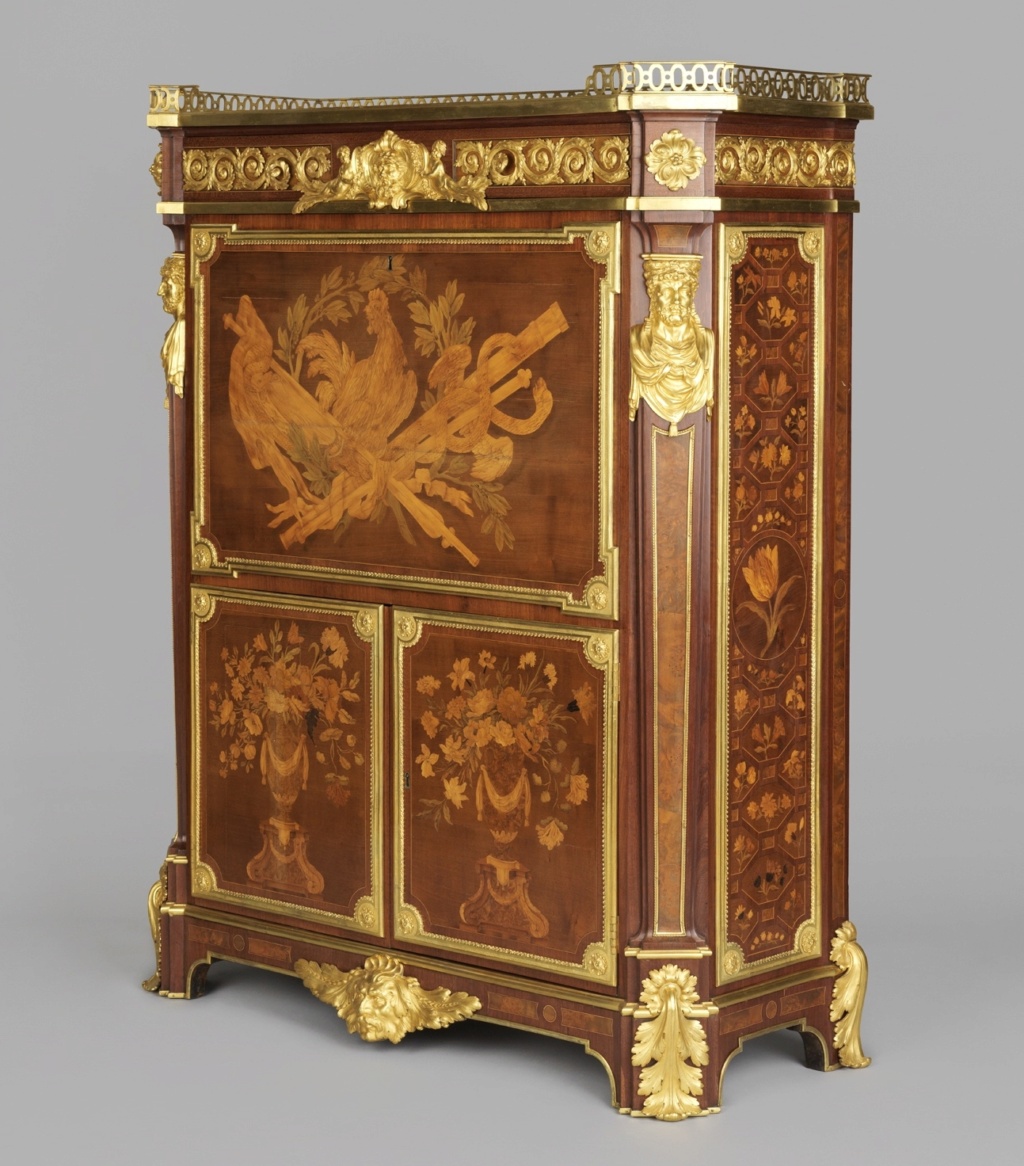
Secrétaire
Jean-Henri Riesener
France, 1780
Oak, sycamore, amaranth, tulipwood, burr walnut, ebony, marble, gilt bronze, brass and leather
Image : The Wallace Collection
Description :
Delivered by Jean-Henri Riesener (1734-1806), Marie-Antoinette's favourite cabinet-maker, on 8 July 1780 for the queen at Versailles, this drop-front writing desk is one of several similar pieces, some stamped by Jean-François Oeben and some by Riesener (who took over the workshop after Oeben’s death), all produced between the early 1760s and 1780. This desk stands out for the quality of both its marquetry and its mounts, in perfect harmony with each other.
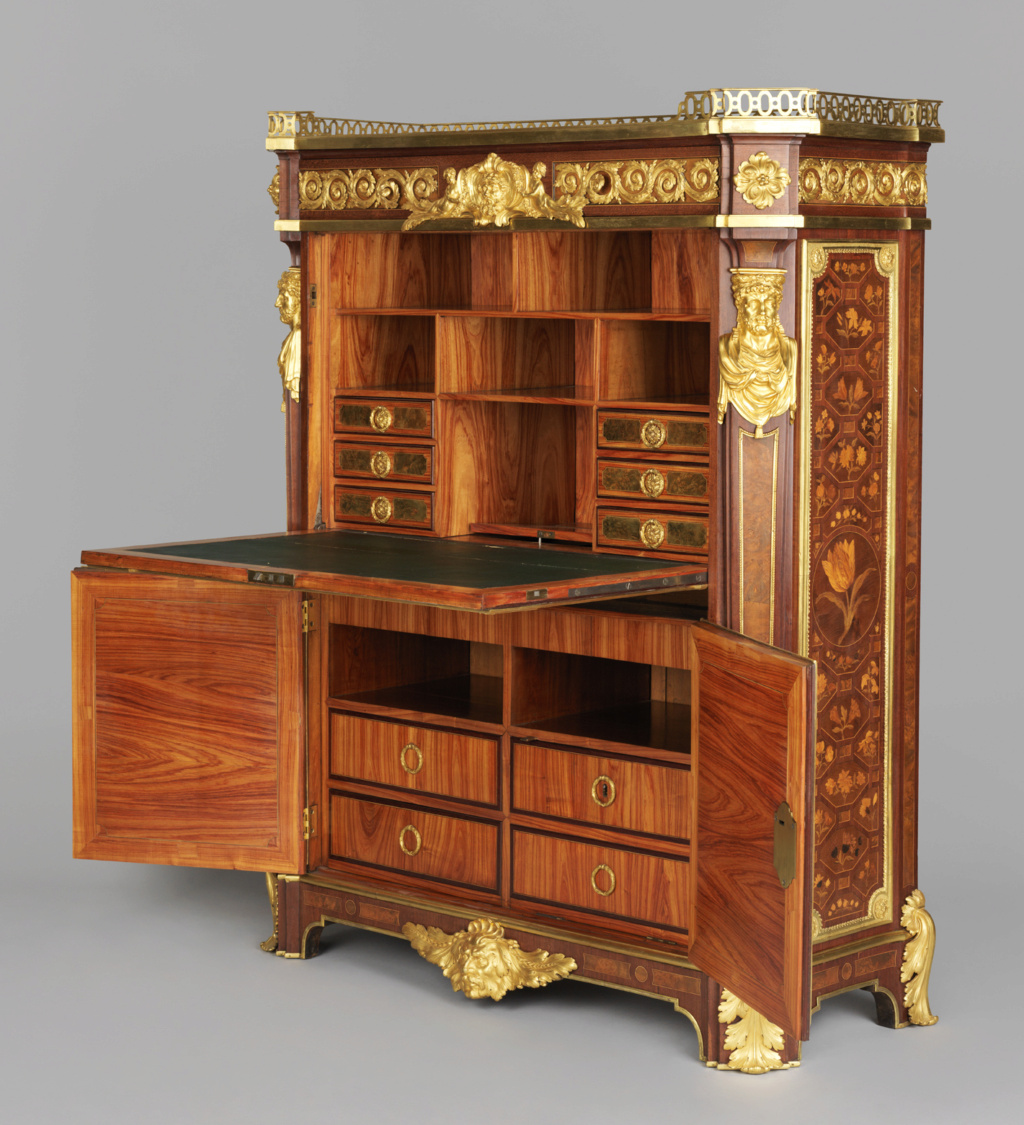
Image : The Wallace Collection
The heavy style of the desk, with its elaborate acanthus mounts and iconographical marquetry, including the cockerel of France on the drop-front, contrasting with the neo-classical male mounts on either side and marquetry urns on the lower doors, suggests that it would have been largely out-of-date when it was delivered. It is perhaps surprising that Riesener produced an old-fashioned model at a time when he was also developing a new style of furniture and decoration for the queen.
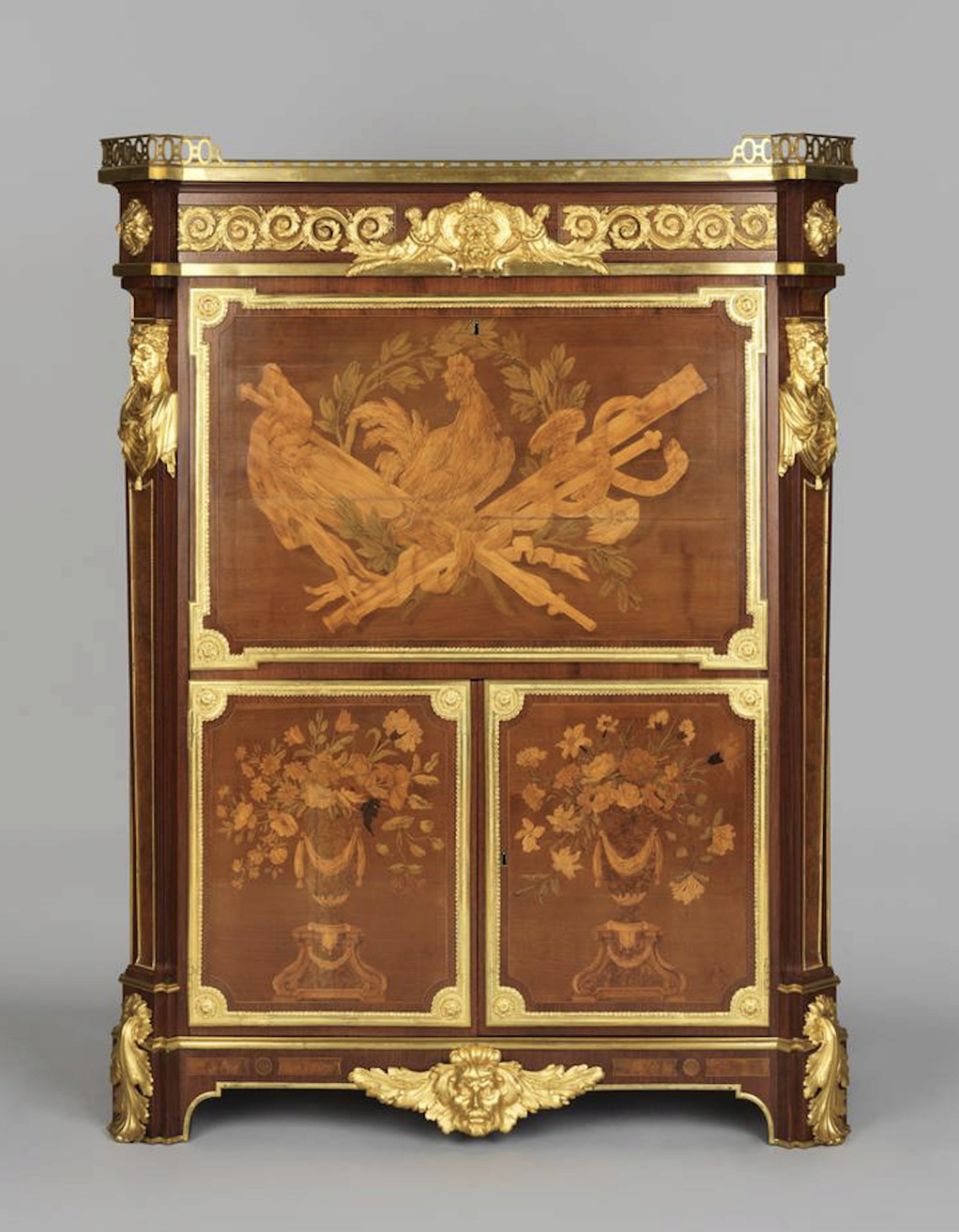
Image : The Wallace Collection
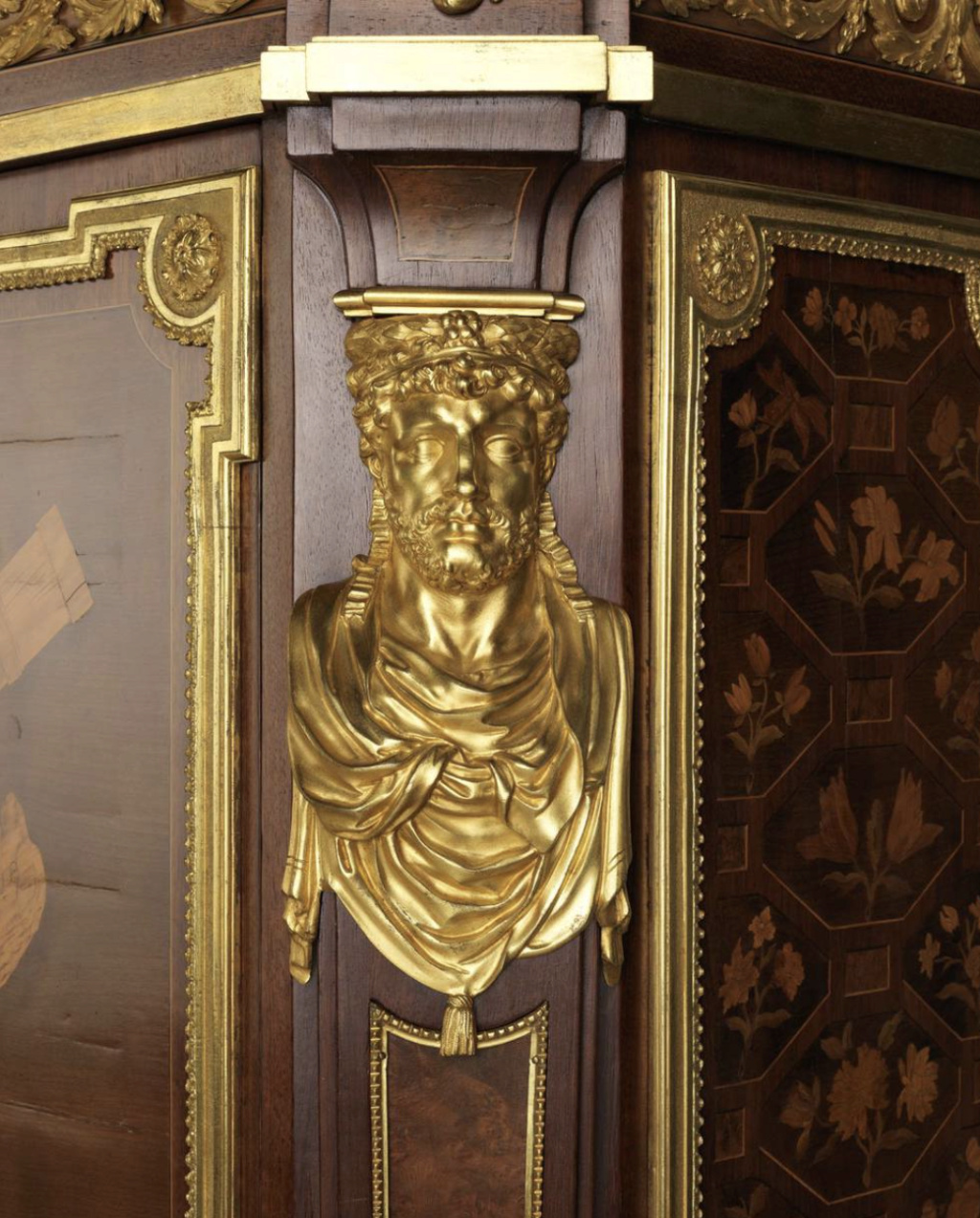
Image : The Wallace Collection
Indeed it was not long before Marie-Antoinette got rid of it and changed the decor in her private study – the desk was sent to another of the royal residences, the Chateau of St Cloud, for the use of Louis XVI.
Riesener replaced it with another, less ponderous desk which had marquetry decoration more in keeping with the queen's leisure pursuits and the decor of the room.
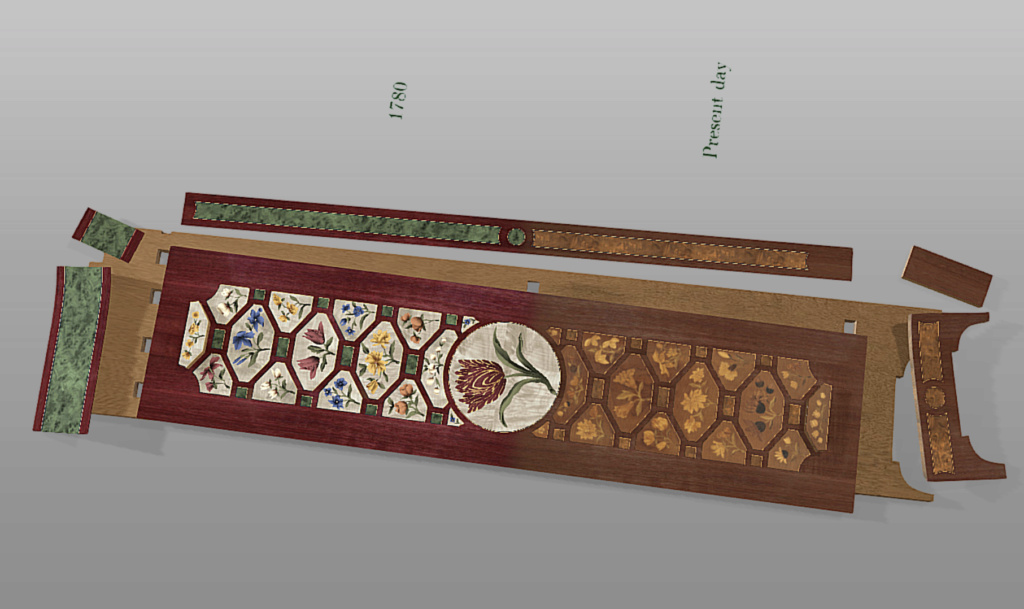
Détail et couleurs d'origine
- Curseur temps de la vidéo poussé à la 29ème minute :
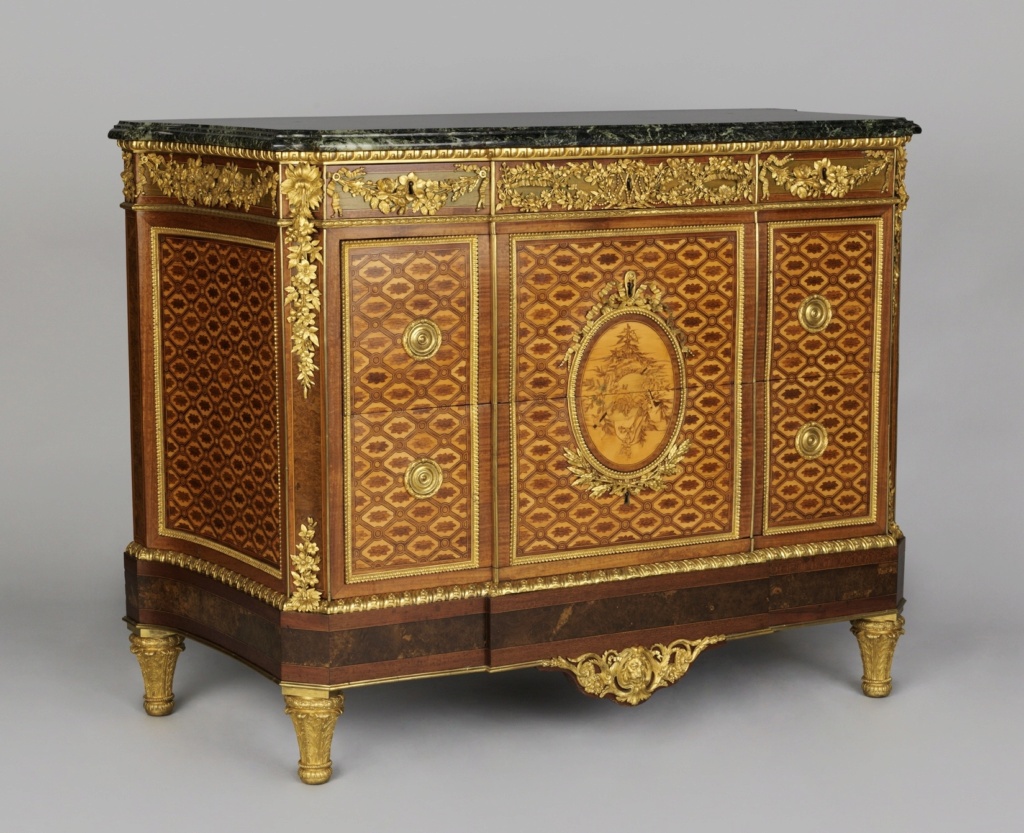
Chest-of-drawers
Jean-Henri Riesener
France, 1780
by 1865 (various alterations made, eg. current marble top added, cornice changed and new mount fixed on apron)
Oak, veneered with amaranth, green-stained sycamore, burr walnut, stringings of ebony and box, fret-pattern marquetry of satiné, holly and stained sycamore, oval marquetry medallion in stained woods on a ground of sycamore originally stained blue, top of vert des Alpes marble, steel lock plate in between main drawers, steel key.
Image : The Wallace Collection
Description :
Marie-Antoinette displayed this chest-of-drawers in one of her private rooms at Versailles, where it harmonised beautifully with the other decoration in the room. When Riesener delivered it, he called it 'a new model', and it marked the beginning of a series of suites of furniture that he was to make for the queen.
Here the gilt-bronze mounts are almost jewel-like in their exquisite form and detail, with perfectly-formed flowers flanking the queen's cypher, her initials ‘MA’. This seems to be a reflection of Marie Antoinette's personal taste, which can perhaps be characterised as an elegant neo-classicism softened by flowers and pastoral reminders.
Riesener remained her favourite cabinet-maker even after the royal administration made attempts to end his position as privileged supplier to the king in 1785.
Recent conservation work has allowed us to understand much more about this piece of furniture. Like other furniture of the 18th century, the original colours have faded considerably over the years.
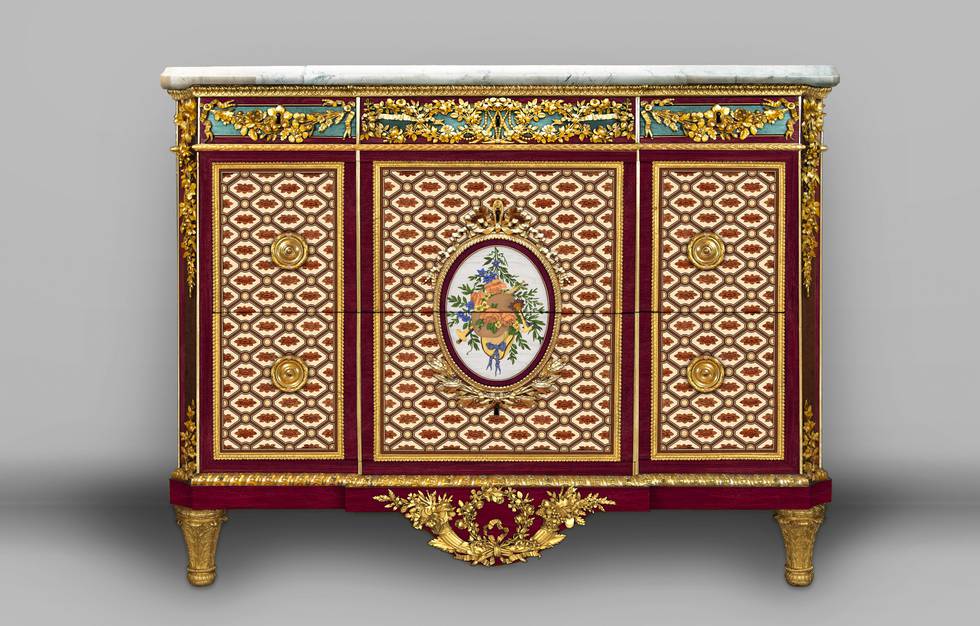
A digital reconstruction of the chest-of-drawers, showing how it might have appeared when Riesener delivered it to Marie-Antoinette in 1780.
For example, the veneer behind the gilt-bronze mounts on the frieze was once stained a turquoise-blue colour, and the pastoral trophy on the front was similarly highly coloured. The reddish and purple tones of the other woods would have made this a highly colourful piece of furniture, blending harmoniously with the embroidered silk wall hangings and the highly-decorated Sèvres porcelain displayed in the room.
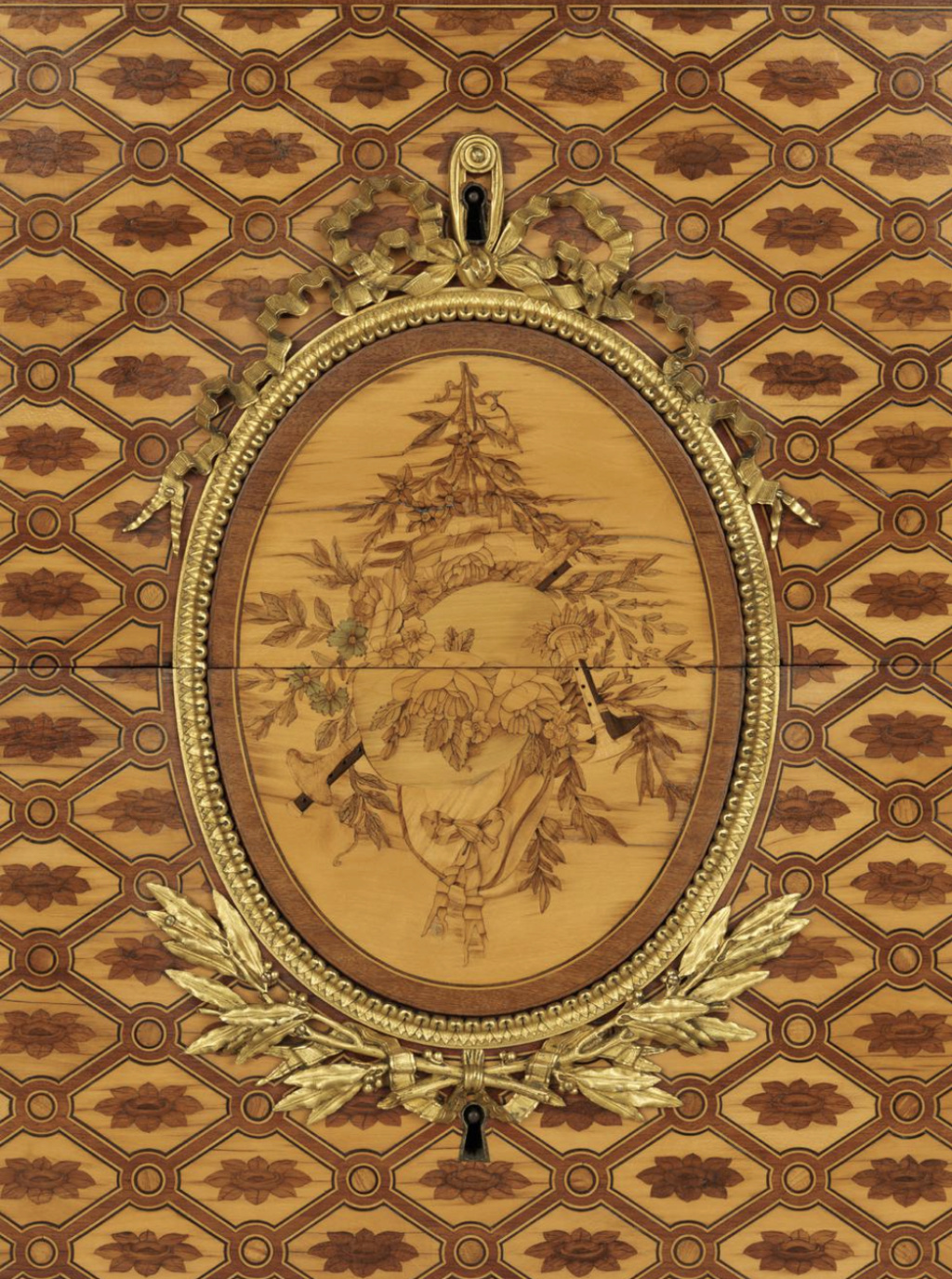
Marie-Antoinette's Chest-of-drawers
Detail of marquetry plaque, showing pastoral attributes.
Image : The Wallace Collection
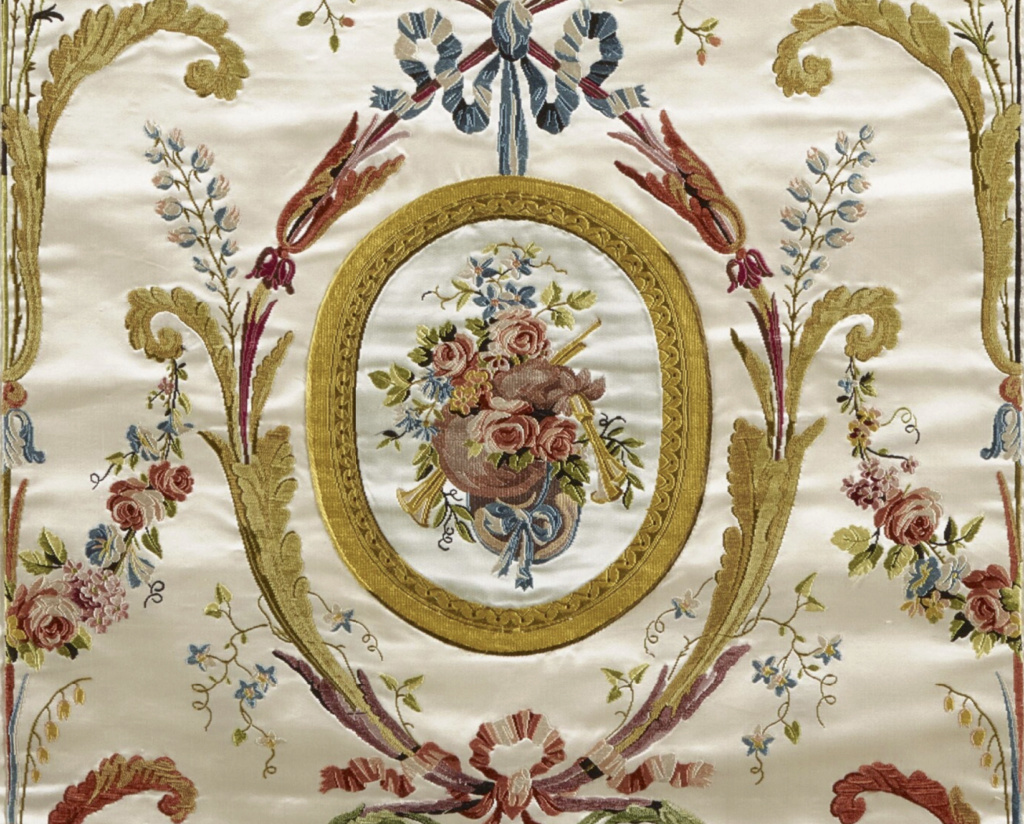
Détail d'un lé de tenture avec médaillon au "trophée musical "
Maison Tassinari et Chatel (fabricant)
d'après Jacques Gondoin (dessinateur)
d'après Jean Charton (fabricant)
France, 1985-1993
Retissage d'après le " meuble " livré par Charton en 1779 pour le cabinet intérieur de Marie-Antoinette à Versailles puis adapté aux proportions du billard de la Reine en 1783.
Retissage effectué à Lyon par la maison Tassinari et Chatel, entre 1985 et 1993, dans le cadre de la restauration du billard de la Reine, achevée en 1993, grâce au mécénat de Lady Michelham.
Image : Château de Versailles, Dist. RMN / Christophe Fouin
The pastoral emblems on the medallion were specifically designed to match one of the trophies in the wall-silk, a special fabric designed by Jacques Gondoin in 1779 for the room and woven at Lyons by Jean Charton.
Originally this commode would have had a top of veined white marble, much more in keeping with neo-classical taste.
A suivre...


La nuit, la neige- Messages : 17787
Date d'inscription : 21/12/2013
 Re: Jean-Henri Riesener, ébéniste du XVIIIe siècle
Re: Jean-Henri Riesener, ébéniste du XVIIIe siècle
Magnifique ! Merci, mon cher Momo . 
Oserais-je dire que je le préfère à celui de Marie-Antoinette ?
Oserais-je dire que je le préfère à celui de Marie-Antoinette ?
_________________
... demain est un autre jour .

Mme de Sabran- Messages : 54657
Date d'inscription : 21/12/2013
Localisation : l'Ouest sauvage
 Re: Jean-Henri Riesener, ébéniste du XVIIIe siècle
Re: Jean-Henri Riesener, ébéniste du XVIIIe siècle
Mais oui, ose ! Il est tellement plus beau 


Gouverneur Morris- Messages : 11352
Date d'inscription : 21/12/2013
 Re: Jean-Henri Riesener, ébéniste du XVIIIe siècle
Re: Jean-Henri Riesener, ébéniste du XVIIIe siècle
Entre autres babioles, Marie-Joséphine put ranger dans ce joli cabinet quelques présents de Louis XV à son arrivée en France . Le duc de Saint-Mégrin ( fils du duc d'Aiguillon ) lui avait remis de la part du roi une parure de perles et de diamants, un collier de perles, des agrafes ( en quoi ? ... en quoi ?!!Gouverneur Morris a écrit:
 ) (
) (  ), des boucles d'oreilles et des bracelets orné de la miniature du comte de Provence enchassée dans un rang de brillants.
), des boucles d'oreilles et des bracelets orné de la miniature du comte de Provence enchassée dans un rang de brillants._________________
... demain est un autre jour .

Mme de Sabran- Messages : 54657
Date d'inscription : 21/12/2013
Localisation : l'Ouest sauvage
 Re: Jean-Henri Riesener, ébéniste du XVIIIe siècle
Re: Jean-Henri Riesener, ébéniste du XVIIIe siècle
Ce devait être seyant ces bracelets à portrait, le visage bouffi de Stautre émergeant des poils de la comtesse...

Gouverneur Morris- Messages : 11352
Date d'inscription : 21/12/2013
 Re: Jean-Henri Riesener, ébéniste du XVIIIe siècle
Re: Jean-Henri Riesener, ébéniste du XVIIIe siècle
... 



_________________
... demain est un autre jour .

Mme de Sabran- Messages : 54657
Date d'inscription : 21/12/2013
Localisation : l'Ouest sauvage
 Re: Jean-Henri Riesener, ébéniste du XVIIIe siècle
Re: Jean-Henri Riesener, ébéniste du XVIIIe siècle
Très intéressante cette reconstruction digitale par la Wallace collection. Cela donne une vraie idée du goût de la reine au XVIIIème siècle. On n'a pas du tout une bonne vision de ces meubles (modifiés au XIXème siècle, usés par le temps) aujourd'hui.
Gouverneur Morris a écrit:Ce devait être seyant ces bracelets à portrait, le visage bouffi de Stautre émergeant des poils de la comtesse...






Duc d'Ostrogothie- Messages : 3182
Date d'inscription : 04/11/2017
Page 2 sur 2 •  1, 2
1, 2
 Sujets similaires
Sujets similaires» Jean-Henri Riesener, Cabinetmaker to Louis XVI and Marie Antoinette. Par H. Jacobsen, R. Bird, M. Jackson
» Mobilier du XVIIIe siècle : décors et marqueterie de nacre
» Paris au XVIIIe siècle
» Jean-Jacques de Boissieu - Lyon et la région lyonnaise à la fin du XVIIIe siècle
» "Marie-Antoinette, « une femme, une femme du XVIIIe siècle » par Pierre-Jean Dufief
» Mobilier du XVIIIe siècle : décors et marqueterie de nacre
» Paris au XVIIIe siècle
» Jean-Jacques de Boissieu - Lyon et la région lyonnaise à la fin du XVIIIe siècle
» "Marie-Antoinette, « une femme, une femme du XVIIIe siècle » par Pierre-Jean Dufief
LE FORUM DE MARIE-ANTOINETTE :: La France et le Monde au XVIIIe siècle :: Les Arts et l'artisanat au XVIIIe siècle :: Le mobilier du XVIIIe siècle
Page 2 sur 2
Permission de ce forum:
Vous ne pouvez pas répondre aux sujets dans ce forum|
|
|
